VIDEO
Products
Streaming
Deliver flawless live video to any audience, anywhere
OTT Apps
Launch and monetize your own branded TV & mobile apps
Spark Encoder
Tap into hardware encoding that's compact and powerful
Broadcaster App
Go live straight from your phone or tablet with studio-quality control
Features
BoxCast Flow
Ensures smooth playback even on shaky networks
Sharing
Instantly clip, share, and amplify your broadcasts
Producer
Create professional streams right from your browser
Third-Party Encoders
Use the gear you love with our support of RTMP and SRT
AUDIO
RemoteMix
Mix live audio remotely from anywhere in the world
Compatible Mixers
Connect your favorite digital mixer to RemoteMix
INDUSTRIES
House of Worship
Reach and engage your congregation wherever they worship
Sports
Stream games with professional quality for fans everywhere
Local Government
Bring transparency and connection to your community broadcasts
Business
Power your corporate events, webinars, and live streams
LEARN
Blog
Insights, trends, and tips for the audio/video community
Tech Tips
Quick how-tos and deep dives on the latest streaming technology
Guides
Essential tips and expert strategies to expand your reach
Newsletter
Stay up to date with product news, best practices, and more
Podcast
Hear stories and strategies from our customers and experts
DISCOVER
Customer Stories
Explore real-world success stories to inspire your organization
Events
Join us at an upcoming conference and meet with our team
Webinars
Get all the details and register for our next live webinar
About Us
Discover our company's mission, values, and team story
Live Streaming Hardware, Church + House of Worship, Live Streaming Software

BoxCast Team • October 7, 2022
While the church faces a myriad of challenges today, connecting with and expanding its reach to more people will always be top priority.
Declining attendance has plagued the church for years — especially with young people — and pandemic health and safety concerns have contributed even more to the decline.
Fortunately, churches and houses of worship are pioneering innovative uses of technology to build community and reach people. More often than not, churches are the institutions that push the envelope of new and effective uses of live streaming tech.
If you're ready to set up live streaming for your church, or just want to learn more before you dive in, you're in the right place. You know the benefits of live streaming for churches. You've done your research about why your church should be live streaming. Now you're ready to figure out how.
While it may seem daunting, just know you're in good hands. We've compiled this guide and other resources so you have all the information, tools, and practical knowledge to create an effective church live stream setup.
Ready? Let's begin.
Before you even think about rolling, you have to form a detailed plan that accounts for all the needs of your stream — as well as the risks you may encounter.
Money makes the world go round. Live streaming is no different, as the quality of your broadcast will depend heavily on the quality of the equipment you use. Better equipment invariably costs more money, so setting a budget for your production is a crucial first step.
You'll need to account for the cost of any gear or software you require and factor in maintenance costs if necessary. Software can often have limited subscriptions, so keeping those valid will also add to expenses.
One of the biggest potential drains on your revenue is the production team itself. Depending on the size of your crew, their level of expertise, and the type of work you expect from them, paying your crew can easily outpace other expenses.
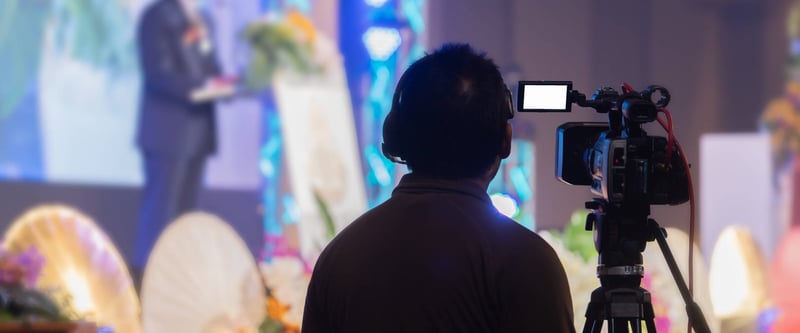
Establishing your production crew should be done with consideration. As mentioned above, the higher the quality of the worker, the greater their compensation will likely need to be. You can cut personnel costs by reducing the team to bare essentials. However, this can increase strain on remaining crew members. So if money’s tight, you might want to enlist amateur AV enthusiasts or volunteers to help lighten the load in the following areas:
Depending on the size of your congregation and scale of your production, some of those roles may become more specialized. Or you may need to have crew members wearing several hats. For smaller congregations, it’s the latter.
Your crew can ultimately look like whatever it needs to — even if some members have more than one duty. There’s no perfect formula, as every production team is different along with every live stream.
Note: If you choose to use amateurs/volunteers, you run the risk of your broadcasts looking less professional.
The hardware and software you use for your streams are heavily dependent on both your budget and crew. It may seem like a bigger price tag means higher quality — that’s only the case if your staff and crew have the technical expertise to operate such equipment. There's no sense spending top dollar on the best gear if your crew doesn't know how to use it. If your team is new to this, you’ll likely have a better experience using gear everyone can understand and learn the basics from.
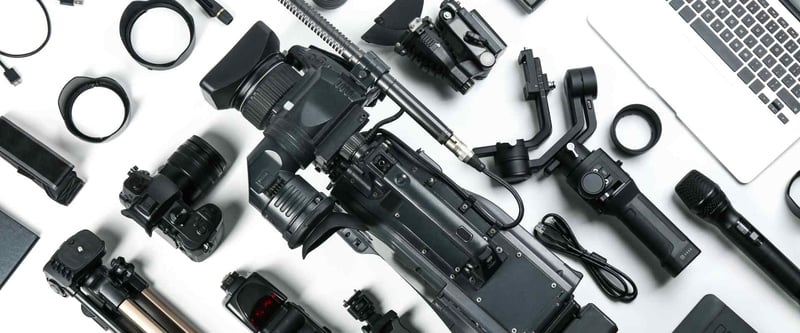
Finding a balance will allow you to create quality broadcasts without burning a hole in your budget. If you really want certain production equipment, remember: It’s critical any operators are appropriately trained in their usage. A lot of these products can be very expensive, and they can often be delicate due to the sophisticated technology included.
Check out our list of the best church streaming equipment for every level.
Most house of worship live streams operate on a weekly basis. Scheduling streams can be a tricky task. You obviously want to broadcast at peak hours, but can you compete with other live streams that broadcast in the same time slot?
For smaller streams, it may be worth occupying a less busy time in order to avoid competition with larger broadcasts. You may be able to attract viewers who are otherwise occupied during peak times, but who still want a live stream experience rather than watching a playback. Regardless of your cadence or schedule, it’s imperative you test your broadcast.
Understanding your audience will pay massive dividends toward the success of your stream. Viewer habits, preferences, and limitations are all majorly helpful insights you can use to fine-tune your live stream to appeal to a greater number of people and a higher level of satisfaction with your service.
Adding tracking metrics to your stream or website can help you learn where your viewers are located, as well as when, how often, and how much of your stream they watch — even on which device!
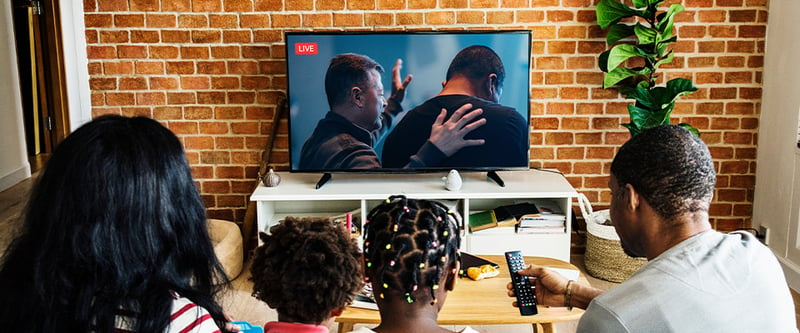
Understanding why viewers may prefer to watch part of your stream rather than all of it can help you to strengthen weaker parts of your broadcast and emphasize what resonates most strongly with desired viewers. If you do a good enough job, your viewers may share your content with others and provide feedback so you have direct insights into what they want next.
Preparing your stage for broadcast will be a routine task every time you stream. So it’s wise to establish ideal positions for your presenter, any mic stands or additional gear, and ensure you’ll be able to get decent lighting and angles from where you position your main camera.
There’s likely little you can do to adjust the stage, since most houses of worship would rather appear as just that rather than as a TV studio. With this in mind, loose or exposed cables and other technical equipment should be set up discreetly and out of the way of anyone on stage. You may have to get creative with how you run your wires depending on your layout.
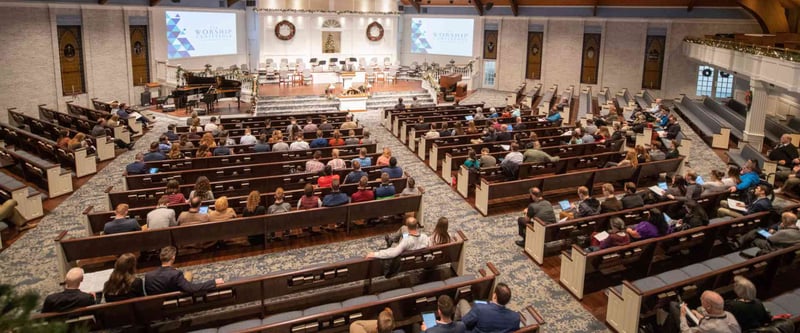
You'll need to identify any available power sources or outlets, and determine which pieces of equipment need to be placed near each power source. Considerations like Wi-Fi availability and noise interference through long cables shouldn’t be ignored, as they can lead to choppy or inaudible streams — then it won't matter how well you've set your stage.
Determine whether your presenter will be moving around the stage during your live stream. A static presenter will make camera operation easier and allow for more stage use since there won't be a risk of your presenter tripping or disconnecting anything as they walk.
If they do plan to move about the stage, this can add a host of new considerations to your setup. You may need a different camera apparatus so you can swivel smoothly to keep the host in frame, or you may opt for a wider shot, in which case you'll need higher overall quality.
Accommodate your presenter if possible. Their comfort onstage will empower them to give the best possible service — which is what you need for your stream to thrive
Camera setup for your stream should primarily cater to your audience. This means you should try to determine what sort of view your audience expects and prefers from your broadcast.
Framing and shot composition should be at the forefront of your mind. Different distances from the presenter can create vastly different impressions on a viewer. For example, close-ups on the speaker may feel intimate and professional, but lack the sense of immersion and community you might achieve with a camera positioned closer to the audience to create the illusion that viewers are sitting amongst the crowd.
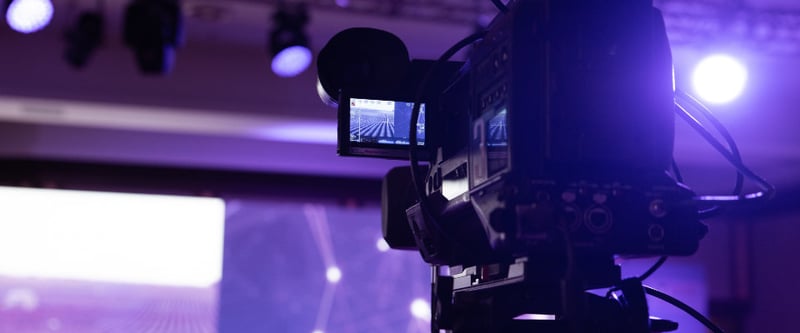
Keep in mind: If you're planning to film from the audience's perspective, you’ll need to make sure you aren't disrupting the physical attendants at the service. You may also need to consider noise cancellation if the audience is speaking.
You could attempt to achieve both of these effects either by switching to a different camera feed or by using the zoom and other features on your camera.
Take care though, because shoddy camera work can make a stream look amateurish and low quality. Don’t overcomplicate your broadcast with cuts or reframing unless you have a top-notch production team. The risk of these effects on your stream simply isn’t worth the reward otherwise.
Getting the right lighting for your stream can be a challenge, depending on where and when you stream.
It’s good to have a dedicated spotlight for your speaker, ideally angled so as to fully illuminate their face and prevent any shadows. That said, there’s a science to stage lighting. We recommend lighting the stage in sections to help organize your lighting structure.

Read this post for tips on setting up your lighting for a church broadcast.
Most churches were built so the entire congregation could see the speaker. For this reason, it’s important to consider several factors to ensure your audio is clear. Configuring your audio setup correctly can make your stream run far more smoothly, and potentially enhance your broadcast in other ways.
Most modern houses of worship now have audio systems installed so the speaker doesn't have to strain to be heard each week.
This is great for broadcasters, as you can easily mix the audio from your church's sound systems into your live stream to get the cleanest sound. For more advanced audio workflows, we also recommend creating a separate mix for your remote audience, as the levels you're feeding the room don't always translate perfectly to the home-viewing experience. Pipe in the audio to your stream as directly as possible for the best sound. Modern broadcasting software should be able to integrate with church systems.

Stationary microphones, attached to mic stands or lecterns, are likely the easiest and least complicated way to do this. You can establish the cables and space you need well ahead of your broadcast, and the locations will be the same each time. This can help to minimize clutter on set, as well as a hard-wired connection being more reliable than Bluetooth.
You'll also need to choose which type of microphone your speaker will be using. As usual, the presenter's preferences should be taken into account, as their comfort and confidence are key parts of what will make your stream successful. If you're setting up new audio systems and your presenter has no preference for microphones, you can try to predict which style will be most effective for your audience.
Another option is to use a wireless lavalier or discreet headset microphone. This has the advantage of keeping the speaker's hands unoccupied so they can be put to use in other ways. It also means they can step away from their place and walk around, engage with audience members, and generally add some energy to your broadcast.
Wireless connections can be less stable, and battery life should be closely monitored so you never lose power mid-stream. Wireless mics can also look a bit awkward and distracting if the mouthpiece or pop-filter are too big.
From equipment recommendations to audio best practices and beyond, BoxCast makes it easy to set up your church live streams. From AV team members to volunteers, we’ve got you covered. Check out our Ultimate Guide to Church Live Streaming for everything you need to achieve your broadcasting goals.
It depends on the size of your congregation, but small to medium-sized churches should look to spend anywhere from $2,500 to $10,000 on live streaming setups. This excludes in-house sound systems, displays, and audio mixers, but includes cameras, switchers, encoders, and graphics software. Depending on whether you plan to start with single-cam or multi-cam workflows will determine how much more you’ll spend on equipment.
Simulated Live, automated scheduling, and simulcasting (aka multistreaming) to social destinations are all important for church live streaming. Simulated Live lets you rebroadcast your previously live worship services and prerecorded announcements throughout the week as if they were live. Automated scheduling makes it easy for you to ensure your stream goes live at the same time every Sunday and weeknight. Simulcasting allows you to extend the reach of your ministry by reaching viewers on virtually any social platform.
While broadcasting your services can be a little more work upfront, the benefits go beyond engaging with a remote audience. That's why we recommend live streaming and recording. With BoxCast, you can do both while taking advantage of Viewer Chat to interact with your audience. Additionally, live streaming your services saves you the hassle of having to offload your recordings and upload them later. It provides your viewers with not only a live experience, but also the ability to watch the recordings after the fact.
If you're diving in to church live streaming for the first time, or if you want to level up your knowledge from the pros who do it all the time, check out these helpful resources:
© 2025 BoxCast. All Rights Reserved. | +1-888-392-2278